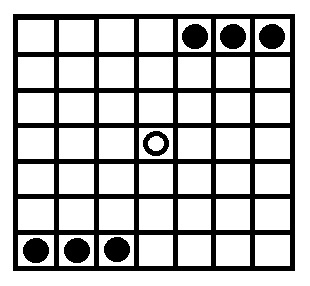Tablero de Yinzer
| Tablero de Yinzer | |
|---|---|
| Designer: | Adam Nelson |
| Year: | unknown |
| Players: | 2 |
| Stuff required: | A 7x7 grod large enough for a shot glass to fit within each square. Seven shot glasses. Two dice. Two bottles of high quality beer. |
| Crew required: | None |
| Preparation: | None. |
| Time required: | 10-15 minutes per game. |
| Place required: | A tabletop |
| Activities: | Strategy, mental arithmetic, drinking. |
| This is a playable game - it's finished, tested and ready to play. | |
| This game is made available under an Attribution-Noncommercial Creative Commons licence. (What does this mean?) | |
History and Influences
Tablero de Yinzer is based on Tablero da Gucci, which in turn is based, allegedly, on a gambling game called Tablero de Jesus. Tablero de Yinzer is the version Tablero da Gucci played in Pittsburgh, as adapted by members of Obscure Games Pittsburgh. Rules for Tablero da Gucci are available on the Tablero da Gucci Wikipedia page.
In the rules below, Tablero de Yinzer is referred to simply as "Tablero." It should be noted that this is also the shortened name for Tablero da Gucci.
Equipment
Seven shot glasses. One 7x7 chess board large enough to accommodate the shot glasses lined up in a horizontal row. One pair of dice (i.e. two six-sided die). Two bottles of quality beer.
Playing Space
Tablero is played on a 7x7 grid, with squares large enough to accommodate the shot glasses.
Number of Players
Two players play at a time. However, each player may choose to have a "second" accompany them and drink in their stead.
Gameplay and Rules
The objective of Tablero is to drink your opponent's beers while hording your own. To do this, players move shot glasses around the board, jumping empty shot glasses over full ones and drinking the jumped glass. To win a round, players must line all the empty glasses up in horizontal, vertical, or diagonal lines, or in a "short" or "long" chevron.
Rules
1. The game begins in a standard setup, as in the image below. Each player fills the three shot glasses closest to them half-way with their beer. The glass in the middle remains empty.

2. A woman is asked to roll the dice to choose the "Queen's Number" for the game. If there is no woman available, nose goes. The Queen's Number cannot be 7, 11, or 12.
3. Each player rolls one die to decide who goes first. High number wins.
4. The first player rolls both dice, and may choose to move one glass the total number shown on the dice, or two glasses the individual numbers shown on the dice, i.e., if a player rolls a "6" and a "3," the player may move one glass three spaces and the other six, or may move one glass nine spaces. The player must move the numbers shown on the dice. In the example above, the player cannot move one glass five spaces and one four spaces, even though the total is still nine spaces.
5. Glasses may move horizontally or vertically, but not diagonally. Players may move in any combination of directions during their turn, but may not cross their path. The exception to this rule is "bouncing" off of the edge of the board, whereby a player may reverse direction once they reach the edge of the board.
6. Players take turns rolling the dice. If a player rolls 7, 11, or 12, they lose their turn. If a player rolls doubles, they get an extra turn.
7. An empty glass may jump over other glasses, but a full glass may not. If a full glass is jumped over, the glass must be drunk by the player who jumped over it, and then returned to its place on the board. A jump counts as one space, not two.
8. If a player rolls the Queen's Number, their opponent must fill an empty glass as a "Toast to the Queen." If six glasses are already full, the player who rolled the Queen's Number may drink a glass of their choosing and have their opponent re-fill it. If, however, the player fails to recognize the Queen's Number, and begins to move, their opponent may call "Treason on the Queen!" and the player who rolled the Queen's Number must now re-fill all empty glasses but one of their opponent's choosing. Note that throughout the game, at lease one glass will always remain empty.
9. A player wins the round when he or she succeeds in making one of the following formations, anywhere on the board (where applicable).

In some styles of play, all glasses must be empty before the formation counts.
10. When a player has won a round, his or her opponent must re-fill all but one of the glasses. The winning player may then arrange the glasses in a symmetrical formation of their choosing, provided that the empty glass is placed in the center of the board. Below are some examples of different starting formations:

Another round begins and the game continues until one player is no longer able to re-fill glasses. Note that it is not customary to win on a Queen's Number, and as such, if a Queen's Number is rolled and the opposing player is unable to fill a glass, the rolling player will fill one instead.
11. To begin a new game, re-set the glasses into the standard starting formation and select a new Queen's Number.